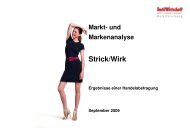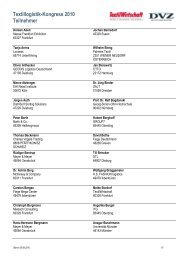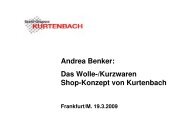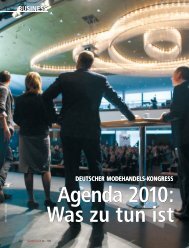UNIQLO Operations - TextilWirtschaft
UNIQLO Operations - TextilWirtschaft
UNIQLO Operations - TextilWirtschaft
Create successful ePaper yourself
Turn your PDF publications into a flip-book with our unique Google optimized e-Paper software.
Group and M&A Strategy<br />
Building a Strong Portfolio and Aiming for Group Net Sales of ¥1 Trillion<br />
and Ordinary Income of ¥150 Billion in 2010<br />
Market Environment<br />
Growth in the world’s apparel and fashion industries in recent<br />
years has been driven by the countries and regions of<br />
Europe, North America, Japan, and other developed countries<br />
in the fashion industry. In 2007, however, there were not<br />
conspicuous megatrends in the industry, and the business<br />
environment has become more challenging. Along with these,<br />
growth in the European, North American, and Japanese markets<br />
has slowed. In addition, economic conditions produced<br />
uncertainty due to the emergence of the subprime loan issues<br />
originating in the United States, and we believe this is gradually<br />
beginning to have an adverse impact on consumer attitudes<br />
toward apparel and other expenditures.<br />
On the other hand, in emerging economies, such as China<br />
and Russia, that are experiencing rapid economic growth,<br />
consumer spending on apparel and fashion items is continuing<br />
to increase, propelled by the strong demand among the<br />
expanding middle-income classes. Yet, even in these emerging<br />
markets, demand is strong for global brands that are popular<br />
in the world’s principal fashion centers, such as New York,<br />
Paris, Milan, London, and Tokyo.<br />
Amid this market environment, most of the top SPA<br />
(Specialty Store Retailer of Private Label Apparel) players with<br />
a global presence are reporting rapid growth and expansion<br />
in market share based on their financial and development<br />
capabilities that derive from economies of scale. As markets<br />
become increasingly global, to survive in today’s torrent,<br />
companies in the apparel and fashion industries are confronted<br />
with the need to develop product offerings that differentiate<br />
them from competitors and establish brands that appeal<br />
to consumers throughout the world.<br />
08<br />
Worldwide Apparel Specialty Stores<br />
Company Name End of Sales* Change (%)<br />
(Flagship Brand) Country Fiscal Year (¥ Billions) (local base)<br />
Gap Inc. U.S. Jan. 2007 1,850 -0.5<br />
Inditex, S.A. (ZARA) Spain Jan. 2007 1,299 +21.6<br />
Limited Brands, Inc. U.S. Jan. 2007 1,238 +10.0<br />
Hennes & Mauritz AB (H & M) Sweden Nov. 2006 1,155 +11.7<br />
NEXT PLC U.K. Jan. 2007 767 +5.7<br />
Liz Claiborne Inc. U.S. Dec. 2006 579 +3.0<br />
FAST RETAILING Japan Aug. 2007 525 +17.0<br />
Polo Ralph Lauren Corporation U.S. Mar. 2007 498 +14.6<br />
Esprit Holdings Limited China June 2007 441 +26.9<br />
Abercrombie & Fitch Co. U.S. Jan. 2007 385 +19.2<br />
Source: Compiled from the annual reports of the companies listed above.<br />
* Figures calculated based on foreign exchange rates as of August 31, 2007.<br />
FAST RETAILING ANNUAL REPORT 2007<br />
Group Strategy<br />
For FAST RETAILING to compete among the world’s top<br />
players, we believe it is essential, at a minimum, for it to<br />
expand its portfolio of Group businesses that have worldclass<br />
capabilities and attain net sales of ¥1 trillion. That is why<br />
we have set a goal of becoming “a Group with annual net<br />
sales of ¥1 trillion and ordinary income of ¥150 billion.”<br />
First, the Group’s core <strong>UNIQLO</strong> operations have established<br />
a position as a top player among SPA enterprises that<br />
are integrated from manufacturing through retail sales.<br />
<strong>UNIQLO</strong> is moving ahead with the development of even more<br />
competitive materials and products by drawing on the<br />
economies of scale of its operations and partnerships with<br />
leading partners. In addition, to establish its position as a<br />
global brand, <strong>UNIQLO</strong> is implementing a flagship store strategy<br />
in the principal fashion cities in Europe and North America.<br />
In parallel with this strategy, in the fast-growing markets of<br />
Asia, <strong>UNIQLO</strong> is accelerating the opening of stores in China<br />
(including Hong Kong) and Korea.<br />
In Japan Apparel operations, we see growth potential in<br />
the footwear business of ONEZONE and VIEWCOMPANY,<br />
the women’s apparel chain store business of CABIN, and the<br />
low-price apparel business of G.U.<br />
In Global Brand operations, COMPTOIR DES COTONNIERS,<br />
PRINCESSE TAM.TAM, and Theory are fully capable of competing<br />
in global markets. We plan to further develop and grow<br />
these brands in world markets and add strong brands to our<br />
portfolio through M&A.<br />
Group Sales Scenario<br />
� <strong>UNIQLO</strong> Japan<br />
� <strong>UNIQLO</strong> International<br />
� Existing Businesses � New Businesses<br />
(Billions of Yen)<br />
1,000<br />
500<br />
0<br />
FY ’06 ’07<br />
’10<br />
Note: Net sales do not include companies accounted for<br />
under the equity method (such as LINK THEORY<br />
HOLDINGS CO.,LTD., and VIEWCOMPANY<br />
CO.,LTD.).













